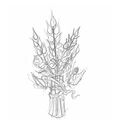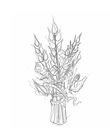The Naked Pint (53 page)
Authors: Christina Perozzi

When fermentation starts to slow down (the bubbles in airlock slow to at least twice a minute), transfer to a secondary fermenter, leaving most of the yeast behind.
Pitch the
Brettanomyces bruxellensis
, which will add carbonation and some rustic, funky notes. Make sure the yeast is well mixed, then bottle immediately.
Brettanomyces bruxellensis
, which will add carbonation and some rustic, funky notes. Make sure the yeast is well mixed, then bottle immediately.
BOTTLING
It is recommended that you bottle and condition this beer in Belgian-style bottles (corked and caged) or Champagne bottles (capped, or corked and caged).
Boil the cane sugar in 4 ounces of water, cool, and add to the fermenter, gently stirring into the solution. Transfer to bottles, and let condition for 2 months. This beer will become more rustic and funky with age but should have a noticeable
Brettanomyces
character within 2 months.
Brettanomyces
character within 2 months.

New Belgium Brewery in Fort Collins, Colorado, was founded by Jeff and Kim Jordan. It has become one of the most popular microbreweries in the world. This environmentally friendly brewery (almost entirely wind powered) is famous for its Fat Tire Amber Ale and for a multitude of Belgian-style ales. We love the green focus of this brewery, and follow closely its specialty series Lips of Faith, which offers cult beers like La Folie, La Fleur, and Dark Kriek. The brewery refers to this series as its playground series, emphasizing the boundary-free imagination that gives birth to unique beers. This recipe is from Chris McCombs, the plant engineer, who first brewed it at the Salt Lake City 2002 Winter Olympics.
Bière de GardeThis Belgian-style ale has a nice complex fruit and spice profile that makes for a fun brewing process. The nuttiness of the malt will be balanced by the hop additions.
SPECIALTY GRAIN BILL 3
1.25 pounds C-40 crystal malt
1.25 pounds flaked oats, unmilled
0.5 pound Carapils malt
1.25 pounds flaked oats, unmilled
0.5 pound Carapils malt
MALT SOURCE 3
6.6 pounds Pale malt extract
1.1 pounds wheat malt extract
1.1 pounds wheat malt extract
HOPPING SCHEDULE
1. 0.625 ounce Tettnang hop pellets, add at 15 minutes
2. 0.5 ounce Cascade hop, add at 75 minutes
2. 0.5 ounce Cascade hop, add at 75 minutes
FIRST SPICE ADDITION (ADD AT 30 MINUTES) 3
1 ounce organic Turkish apricots, chopped
0.1 ounce fresh ginger, chopped
0.125 ounce coriander, ground fresh
0.1 ounce fresh ginger, chopped
0.125 ounce coriander, ground fresh
SECOND SPICE ADDITION (ADD AT 60 MINUTES)
0.94 ounce coriander, ground fresh
0.94 ounce fresh ginger, chopped
0.94 ounce fresh ginger, chopped
YEAST
Wyeast 1056 American Ale combined with Wyeast 5112
Brettanomyces bruxellensis
Brettanomyces bruxellensis
FERMENTATION TEMPERATURE 3
About 74°F
PRIMING SUGAR 3
0.5 pound corn sugar dissolved in 1 cup boiling water and cooled to
room temperature
room temperature
Fill a large brew kettle with about 4 gallons of water, and steep specialty grains in a game bag (which is similar to a large teabag made of cheesecloth) in the brewing water while heating up the water to boiling. Remove the bag before water temperature reaches 175°F. Continue bringing the liquid to a boil.
Remove kettle from the heat, and add the malt extracts, stirring to dissolve. Return the kettle to the heat, bring back to a boil, and set the timer for 15 minutes.
After 15 minutes, add the first hops addition, and set the timer for 15 minutes. Place the ingredients for the first spice addition in a game bag, and add when the timer sounds. Set the timer for 30 minutes.
Place the ingredients for the second spice addition in a game bag, and add to the kettle when the timer sounds. Set the timer for 15 minutes. When the timer sounds, add the second hop addition, remove the brew kettle from the heat, and let rest for 15 minutes.
Cool the wort to about 75°F, and pitch the yeasts.
Ferment at the recommended temperature for 7 to 10 days.
We recommend a secondary fermentation. Transfer the beer to another bucket or carboy for 2 to 4 days more before bottling.
Add the dissolved priming sugar and bottle. We recommend letting the bottles sit for a couple of months for conditioning (so the yeast continues to work, adding a depth of flavor to the beer) before serving.

B
rian Thompson started Telegraph brewery with a focus on hand-crafted unique American ales that embrace the heritage of California’s early brewing pioneers. The brewery uses as many locally grown ingredients as it can, and its award-winning beers embody the philosophy that a local brewery should reflect the traditions of its region. We love the local focus of Telegraph’s beers, and you can find its California Ale and Stock Porter on tap all over Los Angeles.
rian Thompson started Telegraph brewery with a focus on hand-crafted unique American ales that embrace the heritage of California’s early brewing pioneers. The brewery uses as many locally grown ingredients as it can, and its award-winning beers embody the philosophy that a local brewery should reflect the traditions of its region. We love the local focus of Telegraph’s beers, and you can find its California Ale and Stock Porter on tap all over Los Angeles.
We first met Brian in August 2007, when he was kind enough to attend one of our beer dinners at which we were featuring a couple of his delicious beers.
West Coast Belgian AleThis beer is reminiscent of the kinds of beers that were being brewed on the West Coast during the gold-rush era of the 19th century, when American beers were spicy and earthy and represented local ingredients.
SPECIALTY GRAIN BILL
1 pound 40 Lovibond caramel malt
MALT SOURCE
8.25 pounds Pale liquid malt extract
HOPPING SCHEDULE
1. 2.0 ounces Cascade pellets, boil 60 minutes
2. 2.0 ounces Cascade pellets
2. 2.0 ounces Cascade pellets
SPECIAL INGREDIENTS
4 ounces orange peel
2 chamomile teabags
2 chamomile teabags
YEAST
Wyeast 1214 Belgian Ale or White Labs WLP530 Abbey Ale
FERMENTATION TEMPERATURE
70-75°F
PRIMING SUGAR
0.5 pound corn sugar dissolved in 1 cup boiling water and cooled to
room temperature
room temperature
In a small pot, heat 3 or 4 quarts of water to around 150°F (bubbles start to form on the bottom). Remove from the heat, and stir in the specialty grain. Cover and steep for 20 to 30 minutes.
Meanwhile, fill a large brewpot half full with water, and bring to boil. When bubbles start to rise from the pot, turn off the heat and stir in the malt extract.
After the grains have steeped, pour the liquid and grains through a strainer directly into the main brewpot.
Add some hot water to the small pot, and rinse the grains with the strainer in the water to sparge. Add this liquid to the main brewpot.
Bring what is now called wort to a full, rolling boil. Watch for boilovers! Once the foaming stops, add the first hops addition and set the timer for 60 minutes.
Meanwhile, sanitize your fermenter, strainer, airlock, and stopper.
When the timer sounds, add the second hops addition and the special ingredients. Immediately remove from the heat, and let rest for 15 minutes.
Cool the pot in a sink until the sides are cool to the touch.
Pour the wort into the sanitized fermenter, add prechilled water to bring it up to 5 gallons at about 75°F, and pitch the yeast and ferment between 70°F and 75°F.
Bottle with dissolved priming sugar when fermentation is complete. (See Step Ten and Step Eleven on page 224.)

N
ot only is Larry Caldwell the current general manager and beer buyer at the famed Father’s Office in Santa Monica, California, but he also knows more about beer than almost anyone we’ve ever met. His passion and enthusiasm are contagious. He is an avid collector and an award-winning homebrewer. He has introduced us to many great beers, but one of the best ones was a stunning sweet and tart Pomegranate Ale. When we asked him who the brewer was, he said, “I am!” We were astounded and impressed and begged him for the recipe.
Pomegranate Tartot only is Larry Caldwell the current general manager and beer buyer at the famed Father’s Office in Santa Monica, California, but he also knows more about beer than almost anyone we’ve ever met. His passion and enthusiasm are contagious. He is an avid collector and an award-winning homebrewer. He has introduced us to many great beers, but one of the best ones was a stunning sweet and tart Pomegranate Ale. When we asked him who the brewer was, he said, “I am!” We were astounded and impressed and begged him for the recipe.
Larry says: This beer is based loosely on one of our favorite beers, New Glarus Brewing Company’s Wisconsin Belgian Red (see page 81), as well as its Raspberry Tart. Both are beers that feature the fruit strongly to the point of being something between a beer and a cider-style drink. This is a great dessert beer on its own, but also a great pairing with desserts like chocolate truffles and cheesecake.
SPECIALTY GRAIN BILL
12 ounces 60 Lovibond Belgian Caramunich
0.5 ounce Carafa III (huskless debittered black malt)
0.5 ounce Carafa III (huskless debittered black malt)
MALT SOURCE
2 pounds dry light extract
2 pounds dry wheat extract
2 pounds dry wheat extract
HOPPING SCHEDULE
0.5 ounce Saaz Hops, boil 60 minutes
SPECIAL INGREDIENTS
YEAST
1 tube White Labs WLP400 Belgian Wit
7
7
PRIMING SUGAR
4 ounces corn sugar dissolved in ½ cup boiling water and cooled to
room temperature
room temperature
FERMENTATION TEMPERATURE
68-70°F
Heat 2 gallons of water in a steeping pot to 170°F to 172°F. Remove from the heat. Place the grains in a grain bag and add to the pot. The water temperature should drop to 153°F to 155°F once grain is added. The higher mash temperature will leave a fuller-bodied beer. Cover and steep (mash) for 30 minutes.
Bring 4.75 gallons of water to a boil in a large stockpot, and cool to 170°F.
After the grains have steeped, pull the bag out of the steeping pot and dip it in the stockpot (water temperature around 170°F).
Add the water from the steeping pot to the large stockpot, and return to a boil. Allow the grain bag to drain dry in the steeping pot. You can add the reserve liquid to the main boil later.
Just before the liquid in the stockpot comes to a boil, add the malt extracts. Be sure to stir thoroughly so that the extracts don’t clump up and are well integrated into the wort.
Bring the wort to a steady, rolling boil. Immediately add the hops. After 45 minutes, add the Whirlfloc tablet. After 15 minutes more, remove the stockpot from the heat and add the pomegranate molasses, stirring thoroughly to dissolve.
Cool the beer to 65°F to 68°F. Transfer the liquid from the stockpot to a food-grade plastic fermenter. Pitch the yeast. Close the lid, add the airlock, and shake vigorously for 1 to 2 minutes to aerate.
Ferment at the recommended temperature.
Once the fermentation is complete (7 to 10 days, when airlock is no longer bubbling), add the pomegranate juice. This will bring the beer up to 5 gallons. Because the juice is full of sugar, this will kick off another fermentation.
Other books
Wild Fire by Christine Feehan
A.W. Hartoin - Mercy Watts 04 - Drop Dead Red by A.W. Hartoin
PsyCop 1: Among the Living by Jordan Castillo Price
Accused by Janice Cantore
Those Who Fear the Darkness (BloodRunes: Book 2) by Cole, Laura R
Vampire Addiction by Eva Pohler
The Ravenscar Dynasty by Barbara Taylor Bradford
Tiger Threat by Sigmund Brouwer
Promised Land by Robert B. Parker
Bones Would Rain from the Sky: Deepening Our Relationships with Dogs by Suzanne Clothier